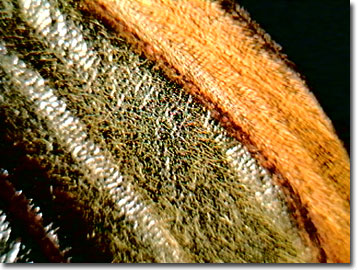Butterfly Wing Scale Digital Image Gallery
Glasswing Butterfly
As delicate as finely blown glass, the presence of this rare tropical gem is used by rainforest ecologists as an indication of high habitat quality and its demise alerts them of ecological change. Rivaling the refined beauty of a stained glass window, the translucent wings of the glasswing butterfly shimmer in the sunlight like polished panes of turquoise, orange, green, and red.

Native to Columbia, Bolivia, Peru, and Ecuador, the glasswing butterfly is usually observed feeding or flying high in the subcanopy of the tropical forest in the Andes Mountains. Members of the species, scientifically classified as Godyris duillia, frequently inhabit elevations of approximately 1,400 meters. Most of the butterflies are large and feature colorful transparent wing panels, but some specimens are a beautiful smoky brown.
Well adapted to the Andean climate and elevation, glasswing butterflies seem incessant in their zigzagging pursuit of flower nectar. Members of the species do not like to rush their meals and may spend hours on a single flower bloom while nectaring. A particular favorite of adult glasswing butterflies is the flowering jungle cucumber vine. Glasswing caterpillars, however, are not such dainty eaters. The larvae rapaciously munch on the leaves of plants, including the deadly nightshades, oleanders, and dogbane. From the poisonous food plants, the glasswing larvae gather toxic alkaloids, which make them unpalatable to predators.
As human populations grow, butterfly populations tend to shrink. Thus, the future of the exotic glasswing butterfly is uncertain. As part of the growing international trade of butterflies, specimens are often taken from the wild, but may also be cultivated for sale on butterfly ranches. Intensive farming with agrochemicals and increased ranching in the Andes greatly threaten the glasswing species and its associates. Other activities that make room for man, such as extensive logging and coal mining, also devastate the crucial habitat of the glasswings.
Contributing Authors
Cynthia D. Kelly, Shannon H. Neaves, Laurence D. Zuckerman, and Michael W. Davidson - National High Magnetic Field Laboratory, 1800 East Paul Dirac Dr., The Florida State University, Tallahassee, Florida, 32310.
BACK TO THE BUTTERFLY WING SCALE IMAGE GALLERY
BACK TO THE DIGITAL IMAGE GALLERIES
Questions or comments? Send us an email.
© 1995-2025 by Michael W. Davidson and The Florida State University. All Rights Reserved. No images, graphics, software, scripts, or applets may be reproduced or used in any manner without permission from the copyright holders. Use of this website means you agree to all of the Legal Terms and Conditions set forth by the owners.
This website is maintained by our
Graphics & Web Programming Team
in collaboration with Optical Microscopy at the
National High Magnetic Field Laboratory.
Last Modification Friday, Nov 13, 2015 at 01:19 PM
Access Count Since January 21, 2003: 9409
Visit the website of our partner in introductory microscopy education:
|
|
